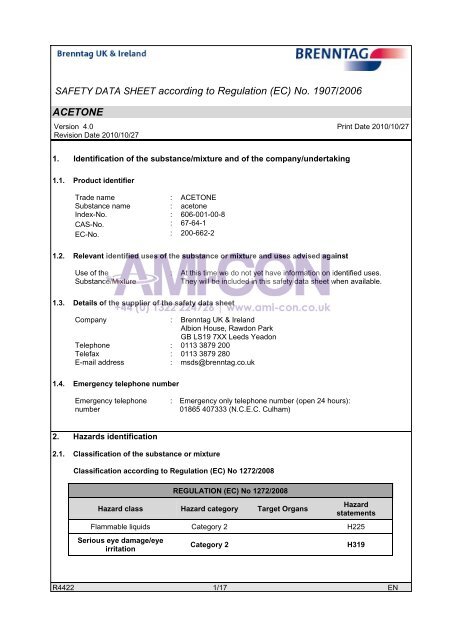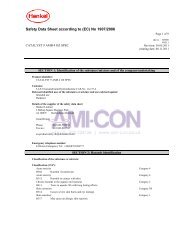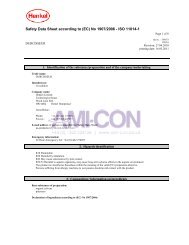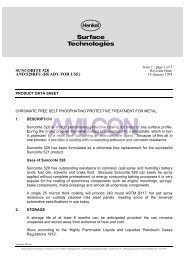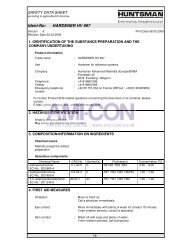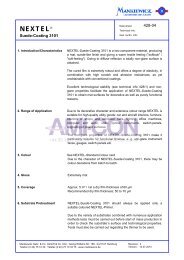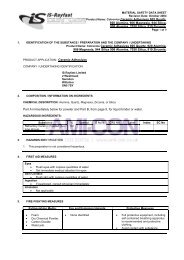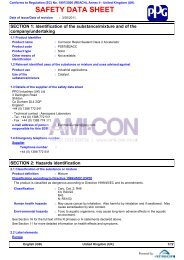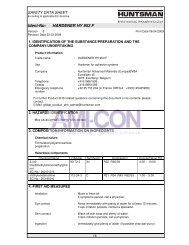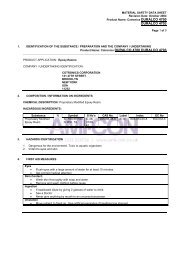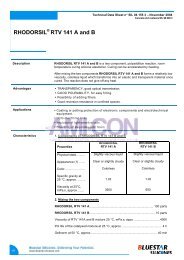SAFETY DATA SHEET according to Regulation (EC) No ... - AMI-CON
SAFETY DATA SHEET according to Regulation (EC) No ... - AMI-CON
SAFETY DATA SHEET according to Regulation (EC) No ... - AMI-CON
Create successful ePaper yourself
Turn your PDF publications into a flip-book with our unique Google optimized e-Paper software.
<strong>SAFETY</strong> <strong>DATA</strong> <strong>SHEET</strong> <strong>according</strong> <strong>to</strong> <strong>Regulation</strong> (<strong>EC</strong>) <strong>No</strong>. 1907/2006ACETONEVersion 4.0 Print Date 2010/10/27Revision Date 2010/10/27Specific target organ<strong>to</strong>xicity - single exposureCategory 3H336Classification <strong>according</strong> <strong>to</strong> EU Directives 67/548/E<strong>EC</strong> or 1999/45/<strong>EC</strong>EU. Directive 67/548/E<strong>EC</strong> or 1999/45/<strong>EC</strong>Hazard symbolsHighly flammable (F)Irritant (Xi)Risk phrasesR11R36R66R672.2. Label elementsLabelling <strong>according</strong> <strong>to</strong> <strong>Regulation</strong> (<strong>EC</strong>) <strong>No</strong> 1272/2008Hazard symbols :Signal word : DangerHazard statements : H225 Highly flammable liquid and vapour.H319Causes serious eye irritation.H336May cause drowsiness or dizziness.Precautionary statementsPrevention : P210 Keep away from heat/sparks/openflames/hot surfaces. - <strong>No</strong> smoking.P280Wear protective gloves/ protective clothing/eye protection/ face protection.Response : P303 + P361 + P353 IF ON SKIN (or hair): Remove/ Takeoff immediately all contaminated clothing.Rinse skin with water/ shower.P305 + P351 + P338 IF IN EYES: Rinse cautiously withwater for several minutes. Remove contactR4422 2/17 EN
<strong>SAFETY</strong> <strong>DATA</strong> <strong>SHEET</strong> <strong>according</strong> <strong>to</strong> <strong>Regulation</strong> (<strong>EC</strong>) <strong>No</strong>. 1907/2006ACETONEVersion 4.0 Print Date 2010/10/27Revision Date 2010/10/27P337 + P313lenses, if present and easy <strong>to</strong> do. Continuerinsing.If eye irritation persists: Get medical advice/attention.S<strong>to</strong>rage : P403 + P235 S<strong>to</strong>re in a well-ventilated place. Keep cool.Additional Labelling:EUH066 Repeated exposure may cause skin dryness or cracking.EUH210 Safety data sheet available on request.Hazardous components which must be listed on the label:• ace<strong>to</strong>ne2.3. Other hazards3. Composition/information on ingredients3.1. SubstancesChemical Name Identification Number: Amount [%]ace<strong>to</strong>neIndex-<strong>No</strong>. : 606-001-00-8CAS-<strong>No</strong>. : 67-64-1<strong>EC</strong>-<strong>No</strong>. : 200-662-2>= 99.64. First aid measures4.1 Description of first aid measuresGeneral adviceIf inhaled: Remove from exposure, lie down. Take off all contaminatedclothing immediately.: Remove <strong>to</strong> fresh air. If breathing is irregular or s<strong>to</strong>pped,administer artificial respiration. If unconscious place inrecovery position and seek medical advice.R4422 3/17 EN
<strong>SAFETY</strong> <strong>DATA</strong> <strong>SHEET</strong> <strong>according</strong> <strong>to</strong> <strong>Regulation</strong> (<strong>EC</strong>) <strong>No</strong>. 1907/2006ACETONEVersion 4.0 Print Date 2010/10/27Revision Date 2010/10/27In case of skin contactIn case of eye contactIf swallowed: Wash off immediately with soap and plenty of water.: Rinse immediately with plenty of water, also under the eyelids,for at least 5 minutes. Consult an eye specialist immediately.Go <strong>to</strong> an ophthalmic hospital if possible.: Clean mouth with water and drink afterwards plenty of water.Never give anything by mouth <strong>to</strong> an unconscious person. Ifswallowed, do not induce vomiting - seek medical advice. If aperson vomits when lying on his back, place him in therecovery position.4.2 Most important symp<strong>to</strong>ms and effects, both acute and delayed4.3 Indication of immediate medical attention and special treatment needed5. Fire-fighting measures5.1. Extinguishing mediaSuitable extinguishingmedia: Use water spray, alcohol-resistant foam, dry chemical orcarbon dioxide.Unsuitable extinguishing : High volume water jetmedia5.2. Special hazards arising from the substance or mixtureSpecific hazards during firefighting: Vapours are heavier than air and may spread along floors.Vapours may form explosive mixtures with air.Flash back possible over considerable distance.In case of fire hazardous decomposition products may beproduced such as:Carbon monoxideCarbon dioxide (CO2)5.3. Advice for firefightersSpecial protectiveequipment for fire-fightersFurther information: In the event of fire, wear self-contained breathing apparatus.Wear appropriate body protection (full protective suit): Cool closed containers exposed <strong>to</strong> fire with water spray.Heating will cause a pressure rise - with risk of bursting.Collect contaminated fire extinguishing water separately. ThisR4422 4/17 EN
<strong>SAFETY</strong> <strong>DATA</strong> <strong>SHEET</strong> <strong>according</strong> <strong>to</strong> <strong>Regulation</strong> (<strong>EC</strong>) <strong>No</strong>. 1907/2006ACETONEVersion 4.0 Print Date 2010/10/27Revision Date 2010/10/27must not be discharged in<strong>to</strong> drains.6. Accidental release measures6.1 Personal precautions, protective equipment and emergency proceduresPersonal precautions: Use personal protective equipment. Keep away unprotectedpersons. Provide adequate ventilation. Keep away from heatand sources of ignition. Avoid contact with skin and eyes. Donot breathe vapours or spray mist. For personal protection seesection 8.6.2 Environmental precautionsEnvironmental precautions: Do not flush in<strong>to</strong> surface water or sanitary sewer system.Avoid subsoil penetration. If the product contaminates riversand lakes or drains inform respective authorities.6.3 Methods and materials for containment and cleaning upMethods and materials forcontainment and cleaningupFurther information: Contain spillage, and then collect with non-combustibleabsorbent material, (e.g. sand, earth, dia<strong>to</strong>maceous earth,vermiculite) and place in container for disposal <strong>according</strong> <strong>to</strong>local / national regulations (see section 13).: Treat recovered material as described in the section "Disposalconsiderations".6.4 Reference <strong>to</strong> other sections7. Handling and s<strong>to</strong>rage7.1 Precautions for safe handlingR4422 5/17 EN
<strong>SAFETY</strong> <strong>DATA</strong> <strong>SHEET</strong> <strong>according</strong> <strong>to</strong> <strong>Regulation</strong> (<strong>EC</strong>) <strong>No</strong>. 1907/2006ACETONEVersion 4.0 Print Date 2010/10/27Revision Date 2010/10/27Advice on safe handlingHygiene measures: Keep container tightly closed. Ensure adequate ventilation. Usepersonal protective equipment. Avoid contact with the skin andthe eyes. Do not breathe vapours or spray mist. Emergencyeye wash fountains and emergency showers should beavailable in the immediate vicinity.: Keep away from food, drink and animal feedingstuffs. Smoking,eating and drinking should be prohibited in the application area.Wash hands before breaks and at the end of workday. Take offall contaminated clothing immediately. Avoid contact with theskin and the eyes. Do not breathe vapours or spray mist.7.2 Conditions for safe s<strong>to</strong>rage, including any incompatibilitiesRequirements for s<strong>to</strong>rageareas and containersAdvice on protectionagainst fire and explosion: Keep in an area equipped with solvent resistant flooring.Suitable materials for containers: Mild steel Stainless steel: Combustible liquid Keep away from sources of ignition - <strong>No</strong>smoking. Use only explosion-proof equipment. Vapours areheavier than air and may spread along floors. Vapours mayform explosive mixtures with air. Take measures <strong>to</strong> prevent thebuild up of electrostatic charge. Use only in an area containingexplosion proof equipment.Further information ons<strong>to</strong>rage conditions: Keep tightly closed in a dry and cool place. Keep away fromdirect sunlight. Keep away from heat. Keep in a well-ventilatedplace.Advice on common s<strong>to</strong>rage : Keep away from food, drink and animal feedingstuffs.Incompatible with oxidizing agents.German s<strong>to</strong>rage class: 3 Flammable Liquids7.3 Specific end uses8. Exposure controls/personal protection8.1. Control parametersR4422 6/17 EN
<strong>SAFETY</strong> <strong>DATA</strong> <strong>SHEET</strong> <strong>according</strong> <strong>to</strong> <strong>Regulation</strong> (<strong>EC</strong>) <strong>No</strong>. 1907/2006ACETONEVersion 4.0 Print Date 2010/10/27Revision Date 2010/10/27ace<strong>to</strong>neOther OELsCAS-<strong>No</strong>.67-64-1Regula<strong>to</strong>ry Basis : EU. Indicative Exposure and Directives relating <strong>to</strong> the protection ofrisks related <strong>to</strong> work exposure <strong>to</strong> chemical, physical, and biologicalagents.Regula<strong>to</strong>ry List : EU ELVValue type : Time Weighted Average (TWA):Value : 500 ppmValue : 1,210 mg/m3Remarks : IndicativeRegula<strong>to</strong>ry Basis : UK. EH40 Workplace Exposure Limits (WELs)Regula<strong>to</strong>ry List : EH40 WELValue type : Time Weighted Average (TWA):Value : 500 ppmValue : 1,210 mg/m3Regula<strong>to</strong>ry Basis : UK. EH40 Workplace Exposure Limits (WELs)Regula<strong>to</strong>ry List : EH40 WELValue type : Short Term Exposure Limit (STEL):Value : 1,500 ppmValue : 3,620 mg/m38.2. Exposure controlsEngineering measuresRefer <strong>to</strong> protective measures listed in sections 7 and 8.Personal protective equipmentRespira<strong>to</strong>ry protectionAdvice : Required, if exposure limit is exceeded (e.g. OEL).In case of insufficient ventilation, wear suitable respira<strong>to</strong>ryequipment.Breathing apparatus with filter.Recommended Filter type:AXHand protectionR4422 7/17 EN
<strong>SAFETY</strong> <strong>DATA</strong> <strong>SHEET</strong> <strong>according</strong> <strong>to</strong> <strong>Regulation</strong> (<strong>EC</strong>) <strong>No</strong>. 1907/2006ACETONEVersion 4.0 Print Date 2010/10/27Revision Date 2010/10/27Advice : The glove material has <strong>to</strong> be impermeable and resistant <strong>to</strong> theproduct / the substance / the preparation.Take note of the information given by the producer concerningpermeability and break through times, and of special workplaceconditions (mechanical strain, duration of contact).Protective gloves should be replaced at first signs of wear.Material : butyl-rubberGloves : >= 4 hGlove thickness : 0.5 mmEye protectionAdvice : Tightly fitting safety gogglesSkin and bodyprotectionAdvice : Solvent resistant protective clothingEnvironmental exposure controlsGeneral advice : Do not flush in<strong>to</strong> surface water or sanitary sewer system.Avoid subsoil penetration.If the product contaminates rivers and lakes or drains informrespective authorities.9. Physical and chemical properties9.1. Information on basic physical and chemical propertiesForm: liquidColourOdour: colourless: sweetOdour Threshold :pH :Freezing point : -94.7 °CBoiling point : 55.8 - 56.6 °CFlash point : -18 °Cclosed cupR4422 8/17 EN
<strong>SAFETY</strong> <strong>DATA</strong> <strong>SHEET</strong> <strong>according</strong> <strong>to</strong> <strong>Regulation</strong> (<strong>EC</strong>) <strong>No</strong>. 1907/2006ACETONEVersion 4.0 Print Date 2010/10/27Revision Date 2010/10/27Upper explosion limit : 13.0 %(V)Lower explosion limit : 2.1 %(V)Vapour pressure : 247 hPa20 °CRelative vapour density : 2.0812 hPa50 °CDensity : 0.791 g/cm320 °CWater solubility : completely misciblePartition coefficient: n-octanol/water : -0.24(measured)Ignition temperature : 540 °CViscosity, dynamic : 0.33 mPa.s20 °COxidizing properties :9.2 Other information10. Stability and reactivity10.1. Reactivity10.2. Chemical stability10.3. Possibility of hazardous reactions10.4. Conditions <strong>to</strong> avoidConditions <strong>to</strong> avoid : Keep away from heat and sources of ignition.10.5. Incompatible materialsMaterials <strong>to</strong> avoid: strong reducing agentsOxidizing agentsHalogenated compoundsAlkali metalsEthanolamineR4422 9/17 EN
<strong>SAFETY</strong> <strong>DATA</strong> <strong>SHEET</strong> <strong>according</strong> <strong>to</strong> <strong>Regulation</strong> (<strong>EC</strong>) <strong>No</strong>. 1907/2006ACETONEVersion 4.0 Print Date 2010/10/27Revision Date 2010/10/27Hydrogen peroxide10.6. Hazardous decomposition productsHazardous decompositionproducts: Under fire conditions:Carbon oxides11. Toxicological information11.1. Information on <strong>to</strong>xicological effectsAcute <strong>to</strong>xicityOralace<strong>to</strong>neCAS-<strong>No</strong>.67-64-1Value type : LD50Value : 5,800 mg/kgSpecies : ratInhalationace<strong>to</strong>neCAS-<strong>No</strong>.67-64-1Remarks : Irritating <strong>to</strong> respira<strong>to</strong>ry system.ace<strong>to</strong>neCAS-<strong>No</strong>.67-64-1Value type : LC50Value : ca. 76 mg/lExposure time : 4 hSpecies : ratDermalR4422 10/17 EN
<strong>SAFETY</strong> <strong>DATA</strong> <strong>SHEET</strong> <strong>according</strong> <strong>to</strong> <strong>Regulation</strong> (<strong>EC</strong>) <strong>No</strong>. 1907/2006ACETONEVersion 4.0 Print Date 2010/10/27Revision Date 2010/10/27ace<strong>to</strong>neCAS-<strong>No</strong>.67-64-1Value type : LD50Value : 20,000 mg/kgSpecies : rabbitIrritationEyesace<strong>to</strong>neCAS-<strong>No</strong>.67-64-1Species : rabbitResult : Irritating <strong>to</strong> eyes.Remarks : May cause corneal damage.Skinace<strong>to</strong>neCAS-<strong>No</strong>.67-64-1Remarks : Repeated exposure may cause skin dryness or cracking.Sensitisationace<strong>to</strong>neCAS-<strong>No</strong>.67-64-1Species : guinea pigResult : not sensitizingExperiences withhuman exposureFurther information: Symp<strong>to</strong>ms of overexposure may be headache, dizziness,tiredness, nausea and vomiting.Chronic exposure may cause dermatitis.Chronic inhalation causes tiredness, headache and rhinitis.12. Ecological informationR4422 11/17 EN
<strong>SAFETY</strong> <strong>DATA</strong> <strong>SHEET</strong> <strong>according</strong> <strong>to</strong> <strong>Regulation</strong> (<strong>EC</strong>) <strong>No</strong>. 1907/2006ACETONEVersion 4.0 Print Date 2010/10/27Revision Date 2010/10/2712.1. ToxicityAcute <strong>to</strong>xicityFishace<strong>to</strong>neCAS-<strong>No</strong>.67-64-1Species : Oncorhynchus mykissExposure Time : 96 hValue type : LC50Value : 5,540 mg/lSpecies : Lepomis macrochirusExposure Time : 96 hValue type : LC50Value : 8,300 mg/lToxicity <strong>to</strong> daphnia and other aquatic invertebrates.ace<strong>to</strong>neCAS-<strong>No</strong>.67-64-1Species : Daphnia magnaExposure time : 48 hValue type : LC50Value : 12,600 mg/lalgaeace<strong>to</strong>neCAS-<strong>No</strong>.67-64-1Species : Pseudokirchneriella subcapitataExposure time : 48 hValue type : NO<strong>EC</strong>Value : 4,740 mg/lBacteriaR4422 12/17 EN
<strong>SAFETY</strong> <strong>DATA</strong> <strong>SHEET</strong> <strong>according</strong> <strong>to</strong> <strong>Regulation</strong> (<strong>EC</strong>) <strong>No</strong>. 1907/2006ACETONEVersion 4.0 Print Date 2010/10/27Revision Date 2010/10/27ace<strong>to</strong>neCAS-<strong>No</strong>.67-64-1Species : Pseudomonas putidaExposure time : 16 hValue type : NO<strong>EC</strong>Value : 1,700 mg/l12.2. Persistence and degradabilityPersistence and degradabilityBiodegradabilityace<strong>to</strong>neCAS-<strong>No</strong>.67-64-1Biodegradation : 84 %Exposure time : 20 dRemarks : Readily biodegradable12.3. Bioaccumulative potentialBioaccumulationace<strong>to</strong>neCAS-<strong>No</strong>.67-64-1Bioconcentration fac<strong>to</strong>r : < 10(BCF)Remarks : Does not bioaccumulate.12.4. Mobility in soil12.5. Results of PBT and vPvB assessment12.6. Other adverse effectsBiochemical Oxygen Demand (BOD)R4422 13/17 EN
<strong>SAFETY</strong> <strong>DATA</strong> <strong>SHEET</strong> <strong>according</strong> <strong>to</strong> <strong>Regulation</strong> (<strong>EC</strong>) <strong>No</strong>. 1907/2006ACETONEVersion 4.0 Print Date 2010/10/27Revision Date 2010/10/27ace<strong>to</strong>neCAS-<strong>No</strong>.67-64-1Value : 1,900 mg/gIncubation time : 5 dChemical oxygen demandace<strong>to</strong>neCAS-<strong>No</strong>.67-64-1Value : 2,100 mg/gAdditional ecological informationace<strong>to</strong>neCAS-<strong>No</strong>.67-64-1Remarks : Do not flush in<strong>to</strong> surface water or sanitary sewer system.Avoid subsoil penetration.13. Disposal considerations13.1. Waste treatment methodsProductContaminated packagingEuropean Waste CatalogueNumber: Disposal <strong>to</strong>gether with normal waste is not allowed. Specialdisposal required <strong>according</strong> <strong>to</strong> local regulations.Do not let product enter drains.Contact waste disposal services.: Empty contaminated packagings thoroughly. They can berecycled after thorough and proper cleaning.Do not burn, or use a cutting <strong>to</strong>rch on, the empty drum.Risk of explosion.: <strong>No</strong> waste code <strong>according</strong> <strong>to</strong> the European Waste Cataloguecan be assigned for this product, as the intended use dictatesthe assignment. The waste code is established in consultationwith the regional waste disposer.R4422 14/17 EN
<strong>SAFETY</strong> <strong>DATA</strong> <strong>SHEET</strong> <strong>according</strong> <strong>to</strong> <strong>Regulation</strong> (<strong>EC</strong>) <strong>No</strong>. 1907/2006ACETONEVersion 4.0 Print Date 2010/10/27Revision Date 2010/10/2714. Transport information14.1. UN number109014.2. UN proper shipping nameADRRIDIMDG: ACETONE: ACETONE: ACETONE14.3. Transport hazard class(es)ADR-Class(Labels; Classification Code; Hazardidentification <strong>No</strong>; Tunnel restriction code)RID-Class(Labels; Classification Code; Hazardidentification <strong>No</strong>)IMDG-Class(Labels; EmS):::33; F1; 33; (D/E)33; F1; 3333; F-E, S-D14.4. Packaging groupADRRIDIMDG: II: II: II14.5. Environmental hazardsLabeling <strong>according</strong> <strong>to</strong> 5.2.1.8 ADRLabeling <strong>according</strong> <strong>to</strong> 5.2.1.8 RIDLabeling <strong>according</strong> <strong>to</strong> 5.2.1.6.3 IMDGClassification as environmentally hazardous<strong>according</strong> <strong>to</strong> 2.9.3 IMDGClassified as “P” <strong>according</strong> <strong>to</strong> 2.10 IMDG: no: no: no: no: noR4422 15/17 EN
<strong>SAFETY</strong> <strong>DATA</strong> <strong>SHEET</strong> <strong>according</strong> <strong>to</strong> <strong>Regulation</strong> (<strong>EC</strong>) <strong>No</strong>. 1907/2006ACETONEVersion 4.0 Print Date 2010/10/27Revision Date 2010/10/2714.6. Special precautions for user14.7. Transport in bulk <strong>according</strong> <strong>to</strong> Annex II of MARPOL 73/78 and the IBC CodeIMDG: not applicable15. Regula<strong>to</strong>ry information15.1. Safety, health and environmental regulations/legislation specific for the substance or mixture<strong>No</strong>tification status15.2. Chemical Safety Assessment16. Other informationFull text of R-phrases referred <strong>to</strong> under sections 2 and 3.R11R36R66R67Highly flammable.Irritating <strong>to</strong> eyes.Repeated exposure may cause skin dryness or cracking.Vapours may cause drowsiness and dizziness.Full text of H-Statements referred <strong>to</strong> under sections 2 and 3.H225H319H336Highly flammable liquid and vapour.Causes serious eye irritation.May cause drowsiness or dizziness.Further informationR4422 16/17 EN
<strong>SAFETY</strong> <strong>DATA</strong> <strong>SHEET</strong> <strong>according</strong> <strong>to</strong> <strong>Regulation</strong> (<strong>EC</strong>) <strong>No</strong>. 1907/2006ACETONEVersion 4.0 Print Date 2010/10/27Revision Date 2010/10/27Other information : The information provided in this Safety Data Sheet is correct <strong>to</strong>our knowledge at the date of its revision. The information givenonly describes the products with regard <strong>to</strong> safety arrangementsand is not <strong>to</strong> be considered as a warranty or qualityspecification and does not constitute a legal relationship.The information contained in this Safety Data Sheet relatesonly <strong>to</strong> the specific material designated and may not be validfor such material used in combination with any other materialor in any process, unless specified in the text|| Indicates updated section.The information provided in this Safety Data Sheet is correct <strong>to</strong> the best of our knowledge,information and belief at the date of its publication. The information given is designed only as aguidance for safe handling, use, processing, s<strong>to</strong>rage, transportation, disposal and release and is not<strong>to</strong> be considered a warranty or quality specification. The information relates only <strong>to</strong> the specificmaterial designated and may not be valid for such material used in combination with any othermaterials or in any process, unless specified in the text.R4422 17/17 EN


